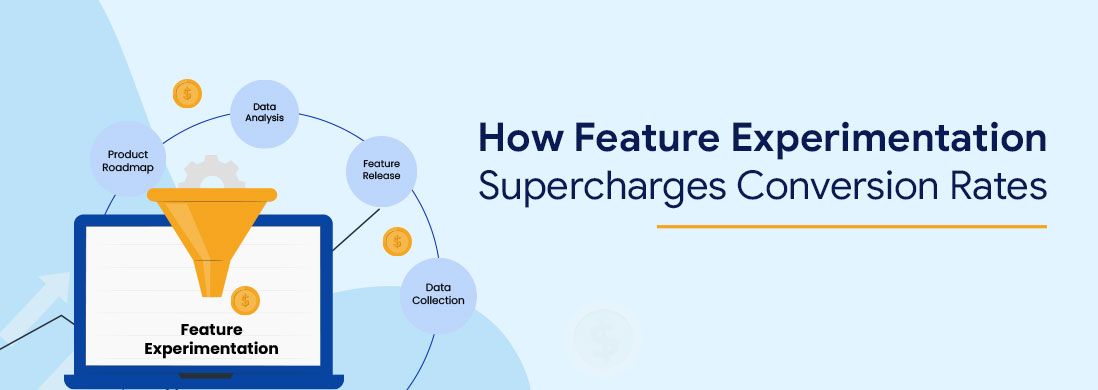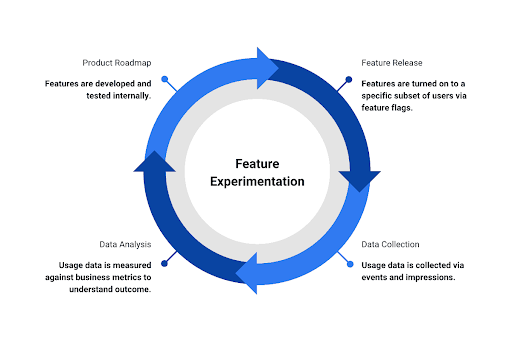Performing feature experimentation is a crucial aspect of Conversion Rate Optimization (CRO) strategies. It involves systematically testing different features on your website or app to identify which ones yield the highest conversion rates. By conducting experiments and analyzing the results, businesses can gain valuable insights into customer behaviour and preferences, allowing them to optimize their digital experiences and drive more conversions.
In this article, we’ll take a look at how feature experimentation can be helpful in optimizing your conversion rates.
What is Feature Experimentation?
Feature experimentation involves testing different variations of a website or app feature to determine which one is most effective in achieving your conversion goals.
For example, you might test different variations of your homepage, product page, or checkout process to see which one results in the highest conversion rate.
 How Feature Experimentations Improve Conversion Rates?
How Feature Experimentations Improve Conversion Rates?
By testing different variations using feature experimentation, you can identify which features and design elements are most effective in driving conversions, and make data-driven decisions to optimize your website or app.
Furthermore, feature experimentation enables you to:
- Identify areas of improvement: By testing different variations, you can identify areas where your website or app is underperforming, and make changes to improve its overall performance.
- Reduce risk: It allows you to test changes on a small scale, thereby reducing the risk of making big changes that may negatively impact your conversion rates.
- Maximize ROI: By identifying the features that drive the highest conversion rates, you can focus your efforts on optimizing those features to maximize your ROI.
What kind of features can tested using Feature Experimentation?
Harnessing the power of experimentation is a vital strategy in optimizing conversion rates (CRO). By conducting tests and analyzing the results, businesses can uncover valuable insights to enhance their digital experiences and drive more desirable outcomes.
Consider the following effective examples of feature experimentation:
Homepage Layout Testing: Explore different layouts to determine which one elicits higher click-through rates, encourages deeper scrolling, or generates more sign-ups. By refining the layout, businesses can capture users’ attention and drive them towards desired actions.
Navigation Menu Optimization: Experiment with diverse colors, positions, and options within the website or app’s navigation menu. This will help identify the most intuitive and user-friendly configuration, making it easier for users to locate desired content or features.
Product Page Elements Experimentation: Test variations of product descriptions, images, and calls to action on product pages to determine the combination that maximizes conversions and leads to more purchases. Fine-tuning these elements can influence user decisions positively.
Checkout Process Testing: Optimize the checkout process by trying out different approaches to reduce cart abandonment rates and increase completed purchases. This may involve streamlining steps, improving clarity, or simplifying forms to enhance the overall user experience.
Onboarding Process Refinement: Experiment with different onboarding processes for new users to identify the most effective approach for facilitating a seamless start and helping users achieve their goals. This will enhance user satisfaction and retention.
Enhanced Search Functionality: Test the effectiveness of various search functionalities, such as auto-suggestions or filters, to improve user experience and ensure users can easily find what they are looking for. This optimization can boost user satisfaction and engagement.
Personalized Content Experimentation: Assess the impact of personalized content on user engagement and purchase behavior. By tailoring content to individual preferences, businesses can cultivate stronger connections with users and drive conversions.
By conducting feature experimentation in these key areas, businesses can gain actionable insights to optimize their digital experiences, increase user engagement, and ultimately achieve higher conversion rates. Embracing a data-driven approach to CRO empowers businesses to continuously refine and enhance their strategies for optimal results.
How to Get Started with Feature Experimentation?
To get started with feature experimentation for CRO, follow these steps:
- Define your conversion goals: These are the actions you want users to take on your website or app? This could include subscribing to a newsletter, making a purchase, etc.. Define your goals and the metrics you’ll use to measure them.
- Identify the features to test: Identify the areas of your website or app that you want to test. This could include your homepage, PDP, checkout process, or any other area that could impact your conversion rates or reduce drop-off.
- Create variations: Create different variations of the features you want to test. For example, you might test different variations of your homepage or product page to see which one results in the highest conversion rate.
- Run the experiment: Run the experiment and collect data on the conversion rates for each variants in the test.
- Analyze the results: Analyze the data to determine which variations performed best and why. Use this information to make data-driven decisions about which features to optimize.
- Iterate and improve: Use the results of your experiments to make improvements to your website or app, and continue testing to optimize your conversion rates.
What is the difference between A/B testing and Feature Experimentation?
A/B testing and feature experimentation are both techniques used in optimization, but they differ in their scope and focus.
A/B testing involves testing two variations of a single feature or element to determine which one performs better. For example, you might test two variations of a landing page headline to see which one generates a higher conversion rate. A/B testing is usually conducted with a single objective in mind and is used to determine which variation of a particular feature or element performs better.
Examples:
- Testing two variations of a website’s landing page headline to see which one results in a higher click-through rate.
- Trying out two variations of an email subject line to see which one leads to a higher open rate.
- Testing two variations of a call-to-action button to see which one results in a higher conversion rate.
- Trying out two different versions of a pricing page to see which one results in more purchases.
- Testing two different layouts for a product page to see which one leads to more conversions.
Feature experimentation, on the other hand, involves testing multiple variations of multiple features or elements to determine which combination results in the best overall performance. Feature experimentation is more complex and involves testing different combinations of features and elements across multiple pages or sections of a website or app. The goal is to identify the optimal combination of features and elements that work together to produce the best overall performance and achieve the desired business goals.
Examples:
- Experimenting with different combinations of product page elements, such as product descriptions, images, videos, reviews, and calls to action to see which combination leads to the highest conversion rate.
- Trying out different checkout processes, such as different numbers of steps, payment options, or the inclusion of security badges to see which one results in fewer cart abandonments and more completed purchases.
- Testing different onboarding processes for new users to see which one leads to more engagement and more users reaching their desired outcome.
- Experimenting with different personalized content, such as recommended products or content based on user behavior or preferences, to see if it leads to more engagement and more purchases.
- Trying out different navigation menus or homepage layouts to see which one makes it easier for users to find what they’re looking for and leads to more engagement.
A/B testing is a useful technique for optimizing specific elements, feature experimentation involves a more holistic approach that considers the entire user experience and aims to optimize the overall performance of a website or app.
Is Feature Experimentation and Multivariate Tests same?
Feature experimentation and multivariate testing are similar in that they both involve testing multiple variations of a website or app to determine which one performs best. However, there are some key differences between the two.
Feature experimentation is a technique that involves testing different combinations of features whereas Multivariate testing involves testing multiple variations of individual elements on a page to determine which combination of elements results in the best performance. This approach tests variations of different elements such as headlines, images, calls to action, and other page elements to determine which combination of elements produces the best overall performance.
Both feature experimentation and multivariate testing involve testing multiple variations to optimize website or app performance, they differ in their approach and scope of testing.
Conclusion:
Feature experimentation is a powerful tool for optimizing your conversion rates. By testing different variations of your website or app features, you can identify the elements that drive the highest conversion rates and make data-driven decisions to optimize your website or app. Follow these steps to get started with feature experimentation and start boosting your conversion rates today.



 How Feature Experimentations Improve Conversion Rates?
How Feature Experimentations Improve Conversion Rates?